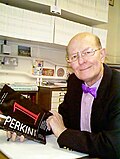Mauveine
Mauveine, also known as aniline purple and Perkin's mauve, is a synthetic organic compound of the formula C_27H_18N_4O_3. It was the first synthetic dye discovered in 1856 by English chemist William Henry Perkin, while he was attempting to synthesize quinine for the treatment of malaria. Mauveine marks the beginning of the synthetic dye and chemical industry, leading to the development of other synthetic dyes and the decline of natural dyes in the late 19th century.
History
The discovery of mauveine was a serendipitous event that occurred when Perkin, at the age of 18, was conducting experiments to synthesize quinine from aniline, a derivative of coal tar. Instead of producing quinine, he obtained a dark sludge. Upon further experimentation, he found that this sludge could be used to dye silk a beautiful shade of purple, which he named mauve. Recognizing the commercial potential of his discovery, Perkin patented the dye and opened a dye works in Greenford. The color mauve became extremely popular, especially after Queen Victoria wore a silk gown dyed with mauveine to the Royal Exhibition of 1862.
Chemical Properties
Mauveine is a mixture of several closely related compounds, with mauveine A and mauveine B being the most prominent. It is synthesized through the oxidation of a mixture of aniline and toluidine with potassium dichromate and sulfuric acid. The chemical structure of mauveine was not fully understood until the 1990s, when advanced analytical techniques such as mass spectrometry and nuclear magnetic resonance were applied.
Impact
The discovery of mauveine had a profound impact on the textile industry, as it allowed for the mass production of a wide range of synthetic dyes, which were more vibrant and colorfast than natural dyes. This innovation led to significant changes in fashion and fabric production, making colorful clothing more accessible to the general public. Furthermore, Perkin's work laid the foundation for the modern chemical industry, paving the way for the synthesis of other important compounds, including pharmaceuticals and explosives.
Legacy
In recognition of his contributions to chemistry and industry, Perkin was knighted in 1906. Today, mauveine is primarily of historical and academic interest, but its discovery is celebrated as a pivotal moment in the field of synthetic chemistry. The Perkin Medal, established in 1906, is awarded annually by the Society of Chemical Industry to a scientist residing in the United States for outstanding work in applied chemistry.
See Also
Transform your life with W8MD's budget GLP-1 injections from $125.
W8MD offers a medical weight loss program to lose weight in Philadelphia. Our physician-supervised medical weight loss provides:
- Most insurances accepted or discounted self-pay rates. We will obtain insurance prior authorizations if needed.
- Generic GLP1 weight loss injections from $125 for the starting dose.
- Also offer prescription weight loss medications including Phentermine, Qsymia, Diethylpropion, Contrave etc.
NYC weight loss doctor appointments
Start your NYC weight loss journey today at our NYC medical weight loss and Philadelphia medical weight loss clinics.
- Call 718-946-5500 to lose weight in NYC or for medical weight loss in Philadelphia 215-676-2334.
- Tags:NYC medical weight loss, Philadelphia lose weight Zepbound NYC, Budget GLP1 weight loss injections, Wegovy Philadelphia, Wegovy NYC, Philadelphia medical weight loss, Brookly weight loss and Wegovy NYC
|
WikiMD's Wellness Encyclopedia |
| Let Food Be Thy Medicine Medicine Thy Food - Hippocrates |
Medical Disclaimer: WikiMD is not a substitute for professional medical advice. The information on WikiMD is provided as an information resource only, may be incorrect, outdated or misleading, and is not to be used or relied on for any diagnostic or treatment purposes. Please consult your health care provider before making any healthcare decisions or for guidance about a specific medical condition. WikiMD expressly disclaims responsibility, and shall have no liability, for any damages, loss, injury, or liability whatsoever suffered as a result of your reliance on the information contained in this site. By visiting this site you agree to the foregoing terms and conditions, which may from time to time be changed or supplemented by WikiMD. If you do not agree to the foregoing terms and conditions, you should not enter or use this site. See full disclaimer.
Credits:Most images are courtesy of Wikimedia commons, and templates, categories Wikipedia, licensed under CC BY SA or similar.
Contributors: Prab R. Tumpati, MD






